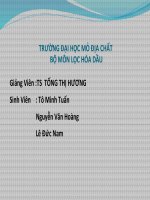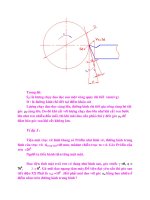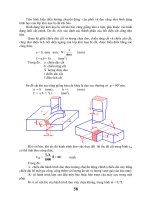CHUYÊN ĐỀ: SẮC KÝ (CƠ SỞ LÝ THUYẾT VÀ ỨNG DỤNG) part 6 pps
Bạn đang xem bản rút gọn của tài liệu. Xem và tải ngay bản đầy đủ của tài liệu tại đây (4.38 MB, 9 trang )
B. Sắc ký khí
(Gas-Liquid Chromatography)
Thermal Conductivity Detector (TCD)
B. Sắc ký khí
(Gas-Liquid Chromatography)
Flame Ionization Detector (FID)
Sensitive towards organics
Analyte is burned in H
2
/air, which produces CH and CHO
+
radicals
CHO
+
radicals are reduced at a cathode which produces a current
proportional to the radical quantity 10
-12
A
Specific for organic carbon, insensitive to inorganics, CO
2
, SO
2
etc.
Generally DL 100x less than TCD about pg/s (flow rate dependent)
Response to specific organic depends on the number of organic carbons.
B. Sắc ký khí
(Gas-Liquid Chromatography)
Electron Capture Detector (ECD)
Sensitive to electron withdrawing groups especially towards organics
containing –F, -Cl, -Br, -I also, -CN, NO
2
Nickel-63 source emits energetic electrons collides with N
2
(introduced as make-
up gas or can be used as carrier gas) producing more electrons:
Ni-63 e
-
, e
-
+ N
2
2e- + N
2
+
The result is a constant current that is detected by the electron collector (anode).
As an analyte flows through past the Ni-63 source, electron capture is possible by
electron-withdrawing species: A + e
-
A
-
Current decreases as a result of e- capture by analyte. This is one of the few
instances in which a signal is produced by a decrease in detectable phenomenon.
Very low DL for detected species 10
-15
g/ml for many halogenated substances
B. Sắc ký khí
(Gas-Liquid Chromatography)
Electron Capture Detector (ECD)
Radioactive Ni-63 source
Easily contaminated with O2, H2O, sample overloading.
High maintenance device.
Highly variable response to halogenated substances
Sometimes complementary information from FID helps.
The bad
Sơ đồ nguyên lý
B. Sắc ký khí
(Gas-Liquid Chromatography)
Một số kỹ thuật chuyển valve
Back flushing Techniques
Mục đích: phân tích các mẫu chứa các
chất tan tương tác mạnh với cột:
nhiễm bẩn cột hoặc thời gian lưu kéo
dài
Valve 8 cổng
Chuyển valve và đảo chiều
chuyển động của pha động
Hạn chế sự nhiễm bẩn của cột
và thời gian phân tích
B. Sắc ký khí
(Gas-Liquid Chromatography)
Một số kỹ thuật chuyển valve
Apparatus for Heart Cutting
Valve 6 ngả
Sử dụng đối hệ thống với hai cột và 2
detectors
Các cấu tử ở vùng giữa của mẫu được
phân tách trên cột 2
Các cẩu tử đầu và cuối được phân
tách trên cột 1
B. Sắc ký khí
(Gas-Liquid Chromatography)
Thu thập và xử lý số liệu (Data Acquisition and Processing )
Nguyên lý
A/D Converter
B. Sắc ký khí
(Gas-Liquid Chromatography)
Một số ứng dụng của GC (GLC)
Áp dụng đối với các mẫu bốc hơi và ổn định nhiệt đến vài trăm °C
Có khả năng phát hiện và phân tích rất nhiều chất và hỗn hợp
Được ứng dụng rộng rãi để tách và xác định các cấu tử trong các mẫu từ
nhiều chủng loại khác nhau
Một vài ví dụ:
☺ Ketones: polydiméthyl siloxane
☺ Alkaloïdes: 5% phenyl polydimethyl siloxane
☺ Steroïds: 50% phenyl polydimethyl siloxane
☺ Chlorinated Aromatics: 50% Trifluoropropyl polydimethyl siloxane
☺ Alcohols: Polyethylenglycol
☺ Esters: 50% Cyanopropyl polydimethyl siloxane
Sắc ký khí kết hợp khối phổ
B. Sắc ký lỏng hiệu quả cao
(Hight-Performance Liquid Chromatography - HPLC)
Phân loại HPLC dựa bản chất tương tác
Sắc ký phân bố (partition chromatography)
Sắc ký hấp phụ hoặc lỏng-rắn (adsorption or liquid-
solid chromatography)
Sắc ký trao đổi ion (ion exchange chromatography)
Sắc ký loại trừ kích thước (size exclusion
chromatography)
SO
3
-
SO
3
-
Na
+
COO
-
H
3
N
+
Na
+
COOH
H
3
N
+
pH2
pH4.5
Ion-exchange Resin
VD: nguyên lý sắc ký trao đổi ion
(acide amine)
Sắc ký loại trừ kích thước









